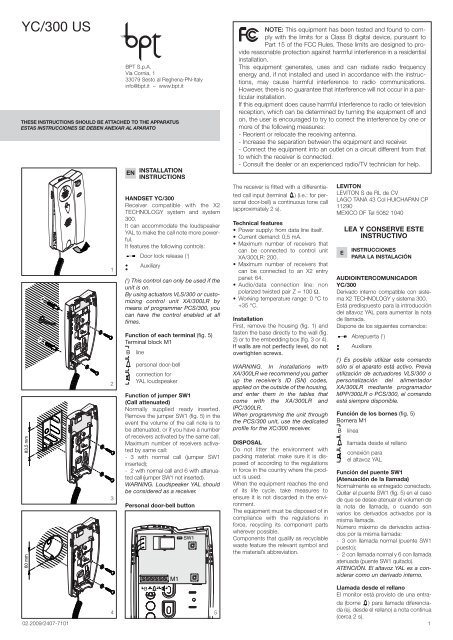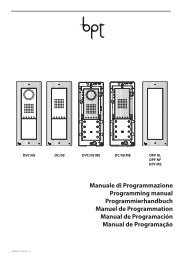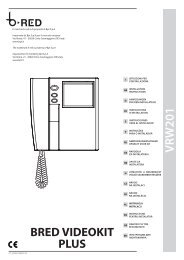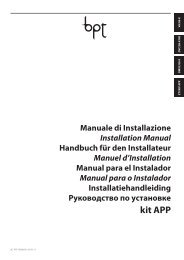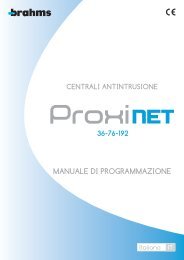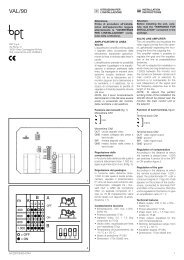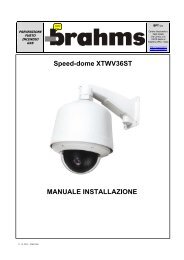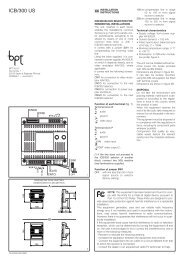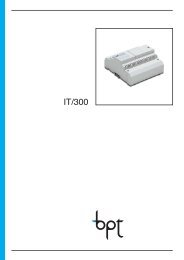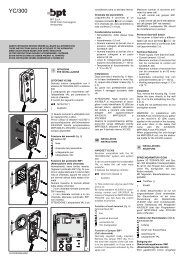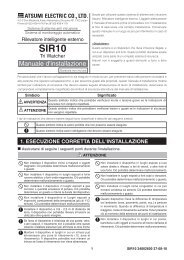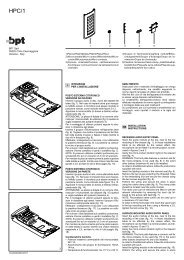YC/300 US - Bpt
YC/300 US - Bpt
YC/300 US - Bpt
Create successful ePaper yourself
Turn your PDF publications into a flip-book with our unique Google optimized e-Paper software.
<strong>YC</strong>/<strong>300</strong> <strong>US</strong><br />
83,5 mm<br />
60 mm<br />
02.2009/2407-7101<br />
1<br />
2<br />
3<br />
4<br />
BPT S.p.A.<br />
Via Cornia, 1<br />
33079 Sesto al Reghena-PN-Italy<br />
info@bpt.it – www.bpt.it<br />
THESE INSTRUCTIONS SHOULD BE ATTACHED TO THE APPARAT<strong>US</strong><br />
ESTAS INSTRUCCIONES SE DEBEN ANEXAR AL APARATO<br />
EN INSTALLATION<br />
INSTRUCTIONS<br />
HANDSET <strong>YC</strong>/<strong>300</strong><br />
Receiver compatible with the X2<br />
TECHNOLOGY system and system<br />
<strong>300</strong>.<br />
It can accommodate the loudspeaker<br />
YAL to make the call note more powerful.<br />
It features the following controls:<br />
Door lock release ( 1 )<br />
Auxiliary<br />
•<br />
( 1 ) This control can only be used if the<br />
unit is on.<br />
By using actuators VLS/<strong>300</strong> or customizing<br />
control unit XA/<strong>300</strong>LR by<br />
means of programmer PCS/<strong>300</strong>, you<br />
can have the control enabled at all<br />
times.<br />
Function of each terminal (fig. 5)<br />
Terminal block M1<br />
B line<br />
personal door-bell<br />
connection for<br />
YAL loudspeaker<br />
Function of jumper SW1<br />
(Call attenuated)<br />
Normally supplied ready inserted.<br />
Remove the jumper SW1 (fig. 5) in the<br />
event the volume of the call note is to<br />
be attenuated, or if you have a number<br />
of receivers activated by the same call.<br />
Maximum number of receivers activated<br />
by same call:<br />
- 3 with normal call (jumper SW1<br />
inserted);<br />
- 2 with normal call and 6 with attenuated<br />
call (jumper SW1 not inserted).<br />
WARNING. Loudspeaker YAL should<br />
be considered as a receiver.<br />
Personal door-bell button<br />
5 7 89<br />
B<br />
M1<br />
SW1<br />
5<br />
NOTE: This equipment has been tested and found to comply<br />
with the limits for a Class B digital device, pursuant to<br />
Part 15 of the FCC Rules. These limits are designed to provide<br />
reasonable protection against harmful interference in a residential<br />
installation.<br />
This equipment generates, uses and can radiate radio frequency<br />
energy and, if not installed and used in accordance with the instructions,<br />
may cause harmful interference to radio communications.<br />
However, there is no guarantee that interference will not occur in a particular<br />
installation.<br />
If this equipment does cause harmful interference to radio or television<br />
reception, which can be determined by turning the equipment off and<br />
on, the user is encouraged to try to correct the interference by one or<br />
more of the following measures:<br />
- Reorient or relocate the receiving antenna.<br />
- Increase the separation between the equipment and receiver.<br />
- Connect the equipment into an outlet on a circuit different from that<br />
to which the receiver is connected.<br />
- Consult the dealer or an experienced radio/TV technician for help.<br />
The receiver is fitted with a differentiated<br />
call input (terminal ) (i.e.: for personal<br />
door-bell) a continuous tone call<br />
(approximately 2 s).<br />
Technical features<br />
• Power supply: from data line itself.<br />
• Current demand: 0,5 mA.<br />
• Maximum number of receivers that<br />
can be connected to control unit<br />
XA/<strong>300</strong>LR: 200.<br />
• Maximum number of receivers that<br />
can be connected to an X2 entry<br />
panel: 64.<br />
• Audio/data connection line: non<br />
polarized twisted pair Z = 100 Ω.<br />
• Working temperature range: 0 °C to<br />
+35 °C.<br />
Installation<br />
First, remove the housing (fig. 1) and<br />
fasten the base directly to the wall (fig.<br />
2) or to the embedding box (fig. 3 or 4).<br />
If walls are not perfectly level, do not<br />
overtighten screws.<br />
WARNING. In installations with<br />
XA/<strong>300</strong>LR we recommend you gather<br />
up the receiver’s ID (SN) codes,<br />
applied on the outside of the housing,<br />
and enter them in the tables that<br />
come with the XA/<strong>300</strong>LR and<br />
IPC/<strong>300</strong>LR.<br />
When programming the unit through<br />
the PCS/<strong>300</strong> unit, use the dedicated<br />
profile for the XC/<strong>300</strong> receiver.<br />
DISPOSAL<br />
Do not litter the environment with<br />
packing material: make sure it is disposed<br />
of according to the regulations<br />
in force in the country where the product<br />
is used.<br />
When the equipment reaches the end<br />
of its life cycle, take measures to<br />
ensure it is not discarded in the environment.<br />
The equipment must be disposed of in<br />
compliance with the regulations in<br />
force, recycling its component parts<br />
wherever possible.<br />
Components that qualify as recyclable<br />
waste feature the relevant symbol and<br />
the material’s abbreviation.<br />
LEVITON<br />
LEVITON S de RL de CV<br />
LAGO TANA 43 Col HUICHAPAN CP<br />
11290<br />
MEXICO DF Tel 5082 1040<br />
E<br />
LEA Y CONSERVE ESTE<br />
INSTRUCTIVO<br />
INSTRUCCIONES<br />
PARA LA INSTALACIÓN<br />
AUDIOINTERCOMUNICADOR<br />
<strong>YC</strong>/<strong>300</strong><br />
Derivado interno compatible con sistema<br />
X2 TECHNOLOGY y sistema <strong>300</strong>.<br />
Está predispuesto para la introducción<br />
del altavoz YAL para aumentar la nota<br />
de llamada.<br />
Dispone de los siguientes comandos:<br />
Abrepuerta ( 1 )<br />
Auxiliare<br />
•<br />
( 1 ) Es posible utilizar este comando<br />
sólo si el aparato está activo. Previa<br />
utilización de actuadores VLS/<strong>300</strong> o<br />
personalización del alimentador<br />
XA/<strong>300</strong>LR mediante programador<br />
MPP/<strong>300</strong>LR o PCS/<strong>300</strong>, el comando<br />
está siempre disponible.<br />
Función de los bornes (fig. 5)<br />
Bornera M1<br />
B línea<br />
llamada desde el rellano<br />
conexión para<br />
el altavoz YAL<br />
Función del puente SW1<br />
(Atenuación de la llamada)<br />
Normalmente es entregado conectado.<br />
Quitar el puente SW1 (fig. 5) en el caso<br />
de que se desee atenuar el volumen de<br />
la nota de llamada, o cuando son<br />
varios los derivados activados por la<br />
misma llamada.<br />
Número máximo de derivados activados<br />
por la misma llamada:<br />
- 3 con llamada normal (puente SW1<br />
puesto);<br />
- 2 con llamada normal y 6 con llamada<br />
atenuada (puente SW1 quitado).<br />
ATENCIÓN. El altavoz YAL es a considerar<br />
como un derivado interno.<br />
Llamada desde el rellano<br />
El monitor está provisto de una entrada<br />
(borne ) para llamada diferenciada<br />
(ej. desde el rellano) a nota continua<br />
(cerca 2 s).<br />
1
NOTA: este equipo ha sido ensayado y declarado conforme a<br />
los límites establecidos para un dispositivo digital de Clase B,<br />
de acuerdo con el Apartado 15 de las Normas FCC. Estos<br />
límites han sido diseñados para ofrecer una protección razonable contra<br />
interferencias perjudiciales en una instalación residencial.<br />
Este equipo genera, utiliza y puede emitir energía de radiofrecuencia y,<br />
si no se instala y utiliza conforme a las instrucciones, puede crear interferencias<br />
perjudiciales para las radiocomunicaciones. Sin embargo, no<br />
se garantiza que no se produzcan interferencias en una instalación concreta.<br />
Si este equipo crea interferencias perjudiciales para la recepción de<br />
radio o televisión, lo cual se puede comprobar apagando y encendiendo<br />
el equipo, se recomienda al usuario que intente corregir la interferencia<br />
adoptando una o varias de las siguientes medidas:<br />
- Modifique la orientación o la posición de la antena receptora.<br />
- Aumente la distancia que separa el equipo del receptor.<br />
- Conecte el equipo a un tomacorriente de un circuito diferente de aquel<br />
al que está conectado el receptor.<br />
- Solicite la asistencia de su distribuidor o de un técnico de radio/TV<br />
cualificado.<br />
Características técnicas<br />
• Alimentación: desde la propia línea<br />
de datos.<br />
• Consumo: 0,5 mA.<br />
• Número máximo de derivados que<br />
se pueden conectar al alimentador<br />
XA/<strong>300</strong>LR: 200.<br />
• Número máximo de derivados que<br />
se pueden conectar a una placa<br />
exterior X2: 64.<br />
• Línea de conexión audio/datos: par<br />
no polarizado Z = 100 Ω.<br />
• Temperatura de funcionamiento: entre<br />
0 °C y +35 °C.<br />
Instalación<br />
Después de haber quitado la caja (fig.<br />
1), fijar la base directamente en la<br />
pared (fig. 2), o en la caja a empotrar<br />
(fig. 3 o 4).<br />
En paredes no perfectamente planas<br />
cabe evitar un apriete excesivo de los<br />
tornillos.<br />
ATENCIÓN. En las instalaciones con<br />
XA/<strong>300</strong>LR se recomienda recoger los<br />
códigos de identificación ID (SN) de<br />
los derivados internos, aplicados al<br />
exterior del meuble, y apuntarlos en<br />
las tablas adjuntas a los aparatos<br />
XA/<strong>300</strong>LR, MPP/<strong>300</strong>LR y IPC/<strong>300</strong>LR.<br />
Si la programación del aparato es<br />
efectuada trçamite MPP/<strong>300</strong>LR, utilizar<br />
el perfil dedicado para el derivado<br />
interno XC/<strong>300</strong>.<br />
ELIMINACION<br />
Comprobar que no se tire al medioambiente<br />
el material de embalaje, sino<br />
que sea eliminado conforme a las normas<br />
vigentes en el país donde se utilice<br />
el producto.<br />
Al final del ciclo de vida del aparato<br />
evítese que éste sea tirado al<br />
medioambiente.<br />
La eliminación del aparato debe efectuarse<br />
conforme a las normas vigentes<br />
y privilegiando el reciclaje de sus<br />
partes componentes.<br />
En los componentes, para los cuales<br />
está prevista la eliminación con reciclaje,<br />
se indican el símbolo y la sigla del<br />
material.<br />
2


